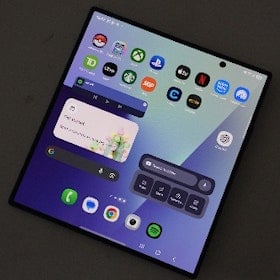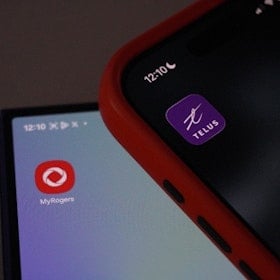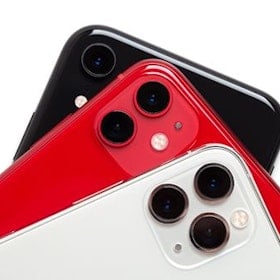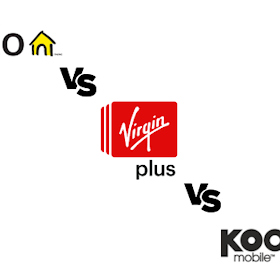 So we’ve had the BlackBerry Z10 for a little a while now and we’ve got a much better idea of the device as a whole. If you’re unfamiliar with the Z10, it’s BlackBerry’s flagship device for the new BB10 operating system. The iconic smartphone manufacturer has ditched its aged, yet popular, mobile OS and started again from the ground up.
So we’ve had the BlackBerry Z10 for a little a while now and we’ve got a much better idea of the device as a whole. If you’re unfamiliar with the Z10, it’s BlackBerry’s flagship device for the new BB10 operating system. The iconic smartphone manufacturer has ditched its aged, yet popular, mobile OS and started again from the ground up.
As such, the BlackBerry Z10, as well as BB10 in general, have both been touted as BlackBerry’s last chance to regain momentum in the mobile market in the face of ever-growing competition from Android, iOS and Windows Phone.
So, is the Z10 a sink or swim device? Actually we found it to be neither; it’s a solid device with an interesting interface, but it’s probably not good enough to completely ‘save’ BlackBerry, nor is it boring or ‘bad’ enough to damn it. Of course, there’s more to it than that. So let’s hop to our BlackBerry Z10 review.
Physical Design of the Z10
We already covered the Z10’s stylish design in our BlackBerry Z10 preview post, but we suppose it can bear a bit of reiteration.
The Z10’s appearance very much suits the overall experience of the device: it’s both elegant and ordinary, incredibly common yet still has that BlackBerry class.
On the outset, the Z10 looks just like an iPhone 5. It’s similar in size, sports the same monolithic black front panel and side profile, has the same rounded corners and sharp, flat edges. Where the eye is caught is the rubberized rear plate. It’s a simple design, but the pattern of the rubberized coating, accented by the chromed blackberry insignia, really does add a lot of style to the Z10. The end result is a device that looks modern, while hinting at luxury.
When held in the hand the Z10 is still quite comfortable, but the initial impression of luxuriousness subsides a bit once you pick it up. It still feels great, thanks to its manageable size and rubberized back, but the tiny flaws that differentiate proper luxury devices from the merely high-end creep out and you’re left with a smartphone that competes with the likes of the iPhone 5 or Galaxy S3 without blowing them out of the water.
One issue is the panels above and below the display. Despite the Z10 featuring no Home/Search/Menu button, there is still a huge amount of room to the top and bottom of the screen. These bezels are, aesthetically, a complete waste of space. This obviously has a functional purpose behind it – that BlackBerry couldn’t fit everything in to a smaller phone – but it ends up detracting from the potential impact of a device that doesn’t require buttons. BlackBerry had a chance to have smaller bezels than any phone that came before and it missed the mark.
Fortunately, we’re so used to this general design; a result of all other phones requirring space for a row of buttons; that it didn’t end up ruining the look, it just didn’t add anything, either.
 Display and UI
Display and UI
The HD 768x1280 4.2 inch display was pretty great. With 355 pixels per inch (ppi) it was more crisp than an iPhone Retina Display, despite being slightly larger. Colors were bright, blacks fairly inky and whites fairly pure. It wasn’t the best screen we’ve ever used in any of these areas, but we wouldn’t say it was particularly lacking in any way. Obviously it couldn't compare to something like a 1080p display with over 400ppi, but it did come out quite a bit before most 1080p handsets started hitting shelves.
Viewing angles weren’t amazing, but we find this is one of those things that reviews can make a big deal of but that the average user will barely ever notice, seeing as few people hold their phone on a sharp angle while playing with it.
The display interface was fast and incredibly smooth, which is all the more important considering that the UI is gesture-based, rather than relying on any capacitive or hardware buttons. Probably the biggest obstacle that we think BlackBerry will face, purely in terms of UI, is that the BB10 interface just isn’t very intuitive, especially for those coming from iOS. That’s not to say that it’s a condusing or difficult-to-use system; it’s actually one of the easiest and most elegant we’ve encountered. The problem is that people will actually have to look up and learn how it works, rather than just twiddling around like they do on other devices.
This may not sound like such a big issue, but believe us for some users it can be. Many smartphone owners have become so spoiled by years of simple and similar UI controls that anything which can't be immediately grasped triggers a reaction of “that’s stupid” or “why didn’t they just…”. As users of multiple different gadgets and OSes, we’ve become used to being a bit patient at times and, at least with BB10, the patience pays off.
It really does only take one short Google search, a 5 minute or so demonstration video and then a bit of playing around to become totally fluent in navigating BB10’s menu screens. The result is a new kind of UI that is, admittedly, not particularly better or worse overall than anything that came before, but it at least offers a teensy bit of fresh air for a field of what often feels like very similar UIs.
The most obvious thing to get used to is the lack of Home button. Instead of this now ubiquitous staple, BB10 relies on the user swiping their finger upwards from the bottom of the screen. It must be the bottom of the screen where the finger starts, otherwise it’s just a normal upwards-swipe comment for scrolling vertically. If this sounds complicated then it isn't. We found that it actually ended up being a bit faster than using a home button, although even after a full week we still found ourselves automatically tapping a key that wasn’t there. Muscle memory can be a cruel mistress.
We’ve already mentioned the Home Screen swipe, but there are a couple more. Swiping up from the bottom of the screen and then, without lifting the finger, swiping to the right brings up the BlackBerry Hub menu. BB Hub is essentially where all of your messages can be found. Facebook, email, BBM, Twitter, SMS etc are all part of the same stream. We initially thought this was going to be a pain, as we’ve been unimpressed with these kind of conglomerate feeds in the past. To our surprise, BB Hub was actually pretty good.
One minor issue is that initially all emails show up individually, even if they’re part of the same subject thread. This can be pretty easily fixed in settings, meaning that each thread only occupies one slot, rather than potentially taking up the entire screen. Unfortunately there doesn’t seem to be a “mark all as read” option. Users can highlight multiple emails at once and then mark as read, but anyone who’s ever been part of a 3-digit email thread before will understand that this isn’t enough of a time saver in extreme situations. Still, it’s better than having to input it individually.
The great thing about the swipe gesture to access BBM is that it can be done from any app or part of the UI. The Home Swipe overrides everything, as it should, so the right-hand swipe directly after it takes you to BB Hub no matter what you’re in the middle of.
Another handy extension of this gesture is when one swipes upward for the home gesture and then holds their finger still. This activates “The Peek”. “The Peek” is basically just a fancy name for BB10 showing you what alerts you have and how many.
Notification icons pop in from the left of the screen, showing you how many SMS, emails, Facebook alerts you have etc. If you see that you only have, for instance, Facebook alerts and you were only checking for missed calls and texts, then you can swipe back down and go back to whatever you were doing. If you do want to respond then swiping to the right once again brings up the BB Hub. It sounds complicated but it’s an elegant system. It’s fast, smooth and becomes second nature pretty quickly.

The Home Screen itself is different to what we’ve traditionally come to expect from a default, go-to display. Instead of a place where all of your favorite apps/widgets/news feeds are found, the BB10 standard is the multi-tasking station. Four apps per screen over 2 screens are displayed with screens being moved between by swiping vertically.
When we first heard about this we thought it was an odd choice, but we ended up feeling like it was a good, but not superior approach. It was handy being able to switch quickly between all of the stuff that we’d been recently doing, especially seeing as the Home Screen can also be accessed by swiping to the left from the BB Hub. This means that, should you be in the middle of an article and check your hub, you can just swipe to the left and tap on said article to return. It’s a really simple way of switching between a variety of functions on your smartphone with minimal lag and effort.
As far as classic BB services go BlackBerry Messenger (BBM) has a few changes to it. For one, users can now send video via the front or rear cameras. There’s also screen sharing, which should have great use for enterprise users. Other than that it seemed the same old BBM with a few aesthetic tweaks here and there.
The ability to switch between personal and work mode should also be a hit with business users. While this ability is becoming more common on high-end releases, BB10 was one of the first, if not the first, big name to offer it. Carrying round one phone instead of two should be a big plus for anyone who’s ever had the privilege of being given a work phone.
As far as the general applications menu went we were pretty unimpressed. The design and layout is so undeniably ‘iOS’ that we actually had a few people mistake the Z10 for some kind of ‘new iPhone’. The iPhone-esque physical design didn’t help with these misunderstandings.
Not only does it look like iOS, but the icons aren’t even as modern. The icon design feels uninspired and out-dated, leaving the user with a boring chunk of the BB10 UI that isn’t as good as what it’s been (most likely) copied from. This really was a big let-down.
The lock screen, too, could have been better. While various notifications are displayed, they can’t be accessed straight from the lock screen. What the user is left with is some almost tauntingly useful notification icons for everything from email to Twitter that look as if they were put there to act as shortcuts, but don't. So much so that we still found ourselves occasionally trying to activate them after a full week.
At least the camera can be jumped straight to from the lock screen. Holding a finger down over the camera icon in the bottom-right activates a timer that eventually opens the camera app. This isn’t as fast or easy as swiping in any direction from the camera icon would be, a la Android, but it was still useful.
The inclusion of this camera shortcut did serve to further highlight the question of why the notification icons on the left were nothing more than undynamic little symbols, surely this tap-and-hold function could have been extended to them as well?
Ultimately what we felt when it came to the BB10 UI was that is was a new approach when it came to the basic gestures. Switching between different parts of already-running functionality was the easiest we’ve ever experienced thanks to the gesture commands, the Mutli-tasking screen and the speed of the UI itself. Unfortunately the general applications menu and the lock screen were big let-downs. They were unoriginal and, in the case of the lock screen, stupefyingly functionless.
It’s an odd mix of great and bad that left us feeling as though BB10 was, indeed, a solid UI experience, but it’s not really better or worse than the main competition just yet. It’s undeniably the best first-generation OS we’ve used (sorry, WP7), but that’s not a reason to go out and buy it. Still, it has huge potential, seeing as BB already has about half of it all down-pat and it’s certainly good enough to be considered competitive.
 Camera
Camera
The camera was pretty average. A couple of generations ago it might have been acceptable, but compared to the massive strides being taken by Nokia, HTC and Samsung recently, it just cannot compete.
Pictures taken during the day came out fairly well, but low-light shots were grainy and out of focus. Basically the camera could be compared to an 8MP camera from the average high-end Android or WP smartphone from 2012; it was passable, but image quality was definitely not impressive.
Time Shift is definitely worth a mention, despite it being pretty closely mirrored in some upcoming competitive releases. Time Shift takes a short video, rather than a single picture. It chooses a certain moment to activate the ‘shutter’ and provides that frame as the picture. Should someone have blinked, or stopped smiling etc, the photographer can highlight each individual person’s face and move it forwards and backwards through different frames. This exact function was demonstrated on both the HTC One and GS4, but BlackBerry has the credit for being the first to show it off way back when the Z10 was first unveiled. It works very well, but would be more of a selling point if the general image quality of the camera were better.
 Apps and Battery Life
Apps and Battery Life
Apps support was probably the Z10’s and BB10’s weakest link. There just aren’t enough apps at this point in time. That was to be expected, of course; all new operating systems go through the agony of slowly building app support. Understandable or not, it’s still a very big issue that’s going to cost BlackBerry a lot of customers.
Curiously, a lot of the apps we downloaded simply didn’t work. The download would complete and the app would install, but as soon as we tapped the icon the app would open and then immediately crash. This wasn’t a one-time deal, either. Apps that crashed always crashed and there were quite a large number of them. The problem has apparently existed since the DevAlpha phase, so how it's stuck around we're not sure.
The standard big-name apps like Facebook and Twitter worked fine. Their layouts and functionality was exactly the same as on Android and iOS and sadly sported none of the aesthetic redesigns that we fell in love with on Windows Phone. That being said, a lot of the bigger titles were still missing and the games that we did manage to run without crashing were simplistic and reminiscent of iOS or Android around 2 years ago, except with HD graphics.
Conversely, battery life was great. The Z10 easily lasted all day with medium-to-heavy use and we didn’t once find ourselves running around looking for a charger. Even gaming didn’t tax it too much, although this may be because the available gaming titles tended to be of the less hardware-taxing variety.
 Browsing and Keyboard
Browsing and Keyboard
The on-screen Keyboard was, hands-down, the best we’ve ever used. BlackBerry’s approach to predictive text is innovative, elegant, fast and incredibly intuitive. It only took a few days to get to learn language patterns to the point where it could fairly accurately suggest follow-up words and the method of display allowed for numerous, rather than just a handful, of suggestions to be displayed at once without cluttering up the screen.
The way BB10 accomplishes this is by inserting a small word suggestion above specific keys, rather than at the top of the keyboard. The key that is chosen is the one the user would have to tap in order to continue spelling the word. That way, the first suggestion that is seen is often the word that’s being typed out anyway. To activate, simply hit the key and swipe upwards and the whole word will be inserted.
This also happens in between words, so any common sayings employed by the typist, or even personal catch-phrases, will also be represented.
This system makes one-handed typing incredibly easy. It does take a little while to learn, but what is required is fairly obvious from the outset, thanks mostly to the intelligent layout. We found that within a week we were using it without a second thought.
We’d even go so far as to say that BB10’s keyboard beats out SwiftKey and Swype in most respects. Even though these are two undeniably fantastic options on Android, BB10’s keyboard really did feel a bit more well-polished, despite it being far younger than either Android staples.
Browsing was pretty standard for a high-end device. The BB10 browser was fast and, as would be expected, benefited greatly from 4G LTE support. Pinch to Zoom worked quite smoothly and pic-heavy websites loaded quickly.
All up there was nothing that stood out too much, nor did anything frustrate us. It was fast, reliable and very standard, which is generally a good combination for a mobile web browser.
 The WhistleOut Opinion
The WhistleOut Opinion
The BlackBerry Z10 is one of the more up and down devices we’ve ever reviewed. Parts of its UI, like the general navigation, multitasking screen and BB Hub, were great. Others, like the uninspired Applications menu were a let-down.
The aesthetic appeal was, too, a mixed bag. The Z10 was definitely an attractive and stylish device, but one of the only features to distinguish it at a quick glance from any one of a number of other phones is the rubberized rear plate. The end result is a great looking phone that somehow manages to also be unremarkable.
The keyboard is definitely one of the major selling points. We realise how weird a sentence that is but we can’t emphasize enough how easy it becomes with just a few days of practice. Email and messaging, even long form correspondence, is all incredibly easy to get through one-handed, despite the smaller 4.2 inch display.
Camera-minded users will probably want to steer clear of the Z10. Image quality wasn’t great and Time Shift, while useful and polished, wasn’t enough to make up for the lacklustre image quality. Instagram is also conspicuously absent, which we hope for BlackBerry’s sake will be fixed soon.
Lack of apps was a major issue, but semi-forgivable from where we’re standing seeing as BB10 is such a young platform.
All in all the Z10 was the best launch device for a new platform that we’ve ever used. BB10 is impressively smooth and modern in many respects. It needs some tweaking and, in some areas, massive aesthetic overhauling, but we never found it particularly frustrating except for the infamous app crashes.
Can the Z10 compete with the upcoming HTC One and Samsung Galaxy S4 releases? Probably not. On the other hand, the BlackBerry Z10 is a promising presentation from BB. The hardware felt modern, the UI felt modern, the experience was smooth and the device was physically, well, modern.
Obviously being ‘modern’ isn’t enough, but we feel as though BlackBerry has finally ‘caught up’ with BB10 and the Z10 and that the future may be more positive than many had assumed. The Z10 surely won’t sink BlackBerry, but it won’t save it, either. What it may do is keep the iconic smartphone manufacturer alive long enough to wow the tech world with its next big upgrade. BB isn’t out of the woods just yet, but there may be a light at the end of the clearing.



Find Better Phones and Plans
Hundreds of cell phone plans unpacked. All the facts. No surprises.







































